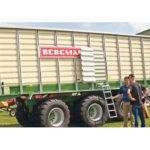WOODSTOCK, Ont. — One major advantage of self-loading forage wagons is they can be fitted with a variety of different conditioners and crimpers, allowing the forage producer to get his hay harvested sooner. Johnathon Scholton brought his Bergmann shuttle 980K self-loading wagon to the Outdoor Farm Show to show off the features of the new […] Read more
Stories by Ron Lyseng
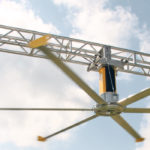
Big Ass fans grab big air and keep it gently flowing
It may be invisible, but air can work for you if you push it around enough, controlling heat and humidity
WOODSTOCK, Ont. — Air is free. It’s all around us. But making it work for us is a whole different matter. When we need to move that air, we need fans. Big fans. “Actually, you need big-ass fans,” states Patrick Wilson, Canadian national sales manager for the company that named themselves just plain “Big Ass […] Read more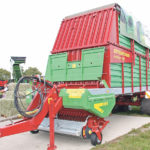
Hey hey, a whole new way to hay
WOODSTOCK, Ont. — Standing hay holds maximum protein, but it’s all downhill from there. Protein drops every time hay is handled. Now, a new system claims to maintain 90 percent of original protein. The Austrian-based Haytec system is common throughout Europe. Using its system, the company says, results in a cost to dry hay of […] Read more

Speed-Tiller comes to Canadian Prairies in a Case
The specialized K-Line Speed-Tiller high-speed disc, engineered to dig like a disc and finish like a finisher in primary and secondary tillage operations, is available to Canadian Prairie farmers. K-Line Ag is an Australian agricultural implement manufacturer known for designing products for challenging soil conditions. Speed-Tiller is one of their most popular implements, with the […] Read more
Mats make the milkers move
WOODSTOCK, Ont. — People like to be comfortable when they sleep, investing heavily in the emerging and changing mattress technology. So why shouldn’t cows and horses expect the same kind of mattress treatment? If plastic cows are your thing, you must go to Canada’s Outdoor Farm Show in Woodstock. Plastic black-and-white cows are everywhere. Comfortable […] Read more
A virtual look at 2020 implement trends
What’s trending next year in the world of farm machinery? That question is being asked by a Wisconsin company called Ag Equipment Intelligence, and it wants you to help find the answer. Looking into farm equipment trends is all AEI does. It is its only job. To help it gather information for the upcoming 2020 […] Read more
Fermentation costs protein and sugar while stabilizing feed
WOODSTOCK, Ont. — The Austrian Haytec system is based on the premise that quality hay preserves protein and sugars better than silage and stretches the milking life of a cow by two years. Haytec factory rep Klaus Wannenmacher was at Canada’s Outdoor Farm Show in September to introduce his company’s innovative haying system to Canadian […] Read more
New nodule knowledge
Plants are masters of self-defense. They know how to protect themselves from disease. Their internal chemistry has evolved to fight off their most common biological enemies found in nature. Understanding the process through which plants protect themselves against pathogens gives researchers a tool with which to make the most of these natural defense mechanisms. Recently […] Read more
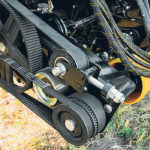
Mechanical drive RDX Grain Belt, air suspended, mechanical drive
Honey Bee used the recent AgriTrade show in Red Deer to show Alberta grain growers its new mechanical drive, 60-foot RDX Grain Belt rigid straight-cut draper header. The new RDX is based on the one-off 60-foot rigid header Honey Bee sent to Australia last year, according to marketing manager Spencer Groth. “The big thing is […] Read more
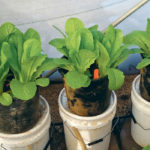
Extract phosphorus from dairy waste water
New technology recycles disappearing essential nutrient to ensure that it doesn’t end up where it isn’t needed
Researchers in Israel have developed a way to create phosphorus fertilizer from dairy waste water. If implemented on a large scale, the process could help stretch Earth’s finite supply of phosphorus. Scientists have warned about a disastrous shortage of phosphorus in 100 to 250 years unless we can find ways to recycle it. Phosphorus is […] Read more

